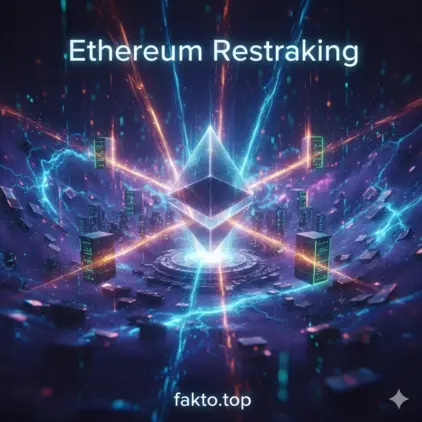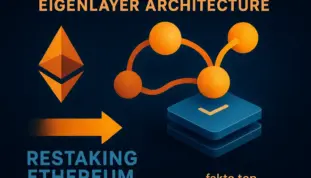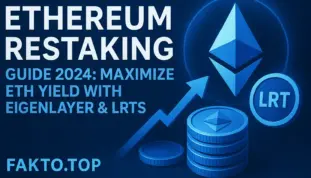Ethereum Restaking Guide: Maximize ETH Yield with EigenLayer & LRTs
The Definitive Guide to Ethereum Restaking: AVS Architecture, Dynamics, and Dual-APY Strategies
Mastering the Ethereum restaking protocol is now essential for maximizing ETH yield and navigating the rapidly evolving landscape of decentralized finance. Restaking represents a paradigm shift, transforming ETH from a singular security asset into a reusable, layered resource. This guide provides a comprehensive deep dive into how a restaking protocol enables ETH holders to layer their assets across multiple network operations, known as Actively Validated Services (AVS), unlocking advanced reward strategies without deploying additional capital.

We will break down the EigenLayer architecture and validator dynamics, exploring how this modular structure enhances the security of the broader Ethereum ecosystem while simultaneously creating unprecedented earning opportunities. The discussion will cover core mechanisms like delegated staking and validator onboarding for newcomers, and delve into sophisticated concepts such as liquid staking and LRT token mechanics for advanced users seeking dual APY strategies. Finally, we will cover critical topics like security and slashing risks and effective yield optimization. By the end, readers will possess the strategic knowledge required for informed and safe participation in Ethereum restaking.
EigenLayer Architecture and Validator Dynamics
The innovation at the heart of the ecosystem is the EigenLayer architecture. It introduces the concept of cryptoeconomic security re-use. Essentially, ETH that is already staked to secure the main Ethereum Proof-of-Stake consensus layer can be “restaked” to secure various auxiliary services (AVS). These services, which can range from new data availability layers and decentralized sequencers to specialized oracles, “rent” security from the collective pool of restaked ETH.
This modular system relies on validator dynamics where an individual validator (or a delegated stake) agrees to enforce the rules of both Ethereum and the chosen AVS. In return for providing this layered security, restakers receive rewards from both the base Ethereum staking and the AVS. This setup significantly increases the capital efficiency of staked ETH while bootstrapping the security of new decentralized services from day one. Understanding these dynamics is the first step toward effective participation in the restaking protocol.
Delegated Staking and Validator Onboarding
For most participants, especially beginners and semi-advanced users, direct node operation is too complex. Delegated staking solves this by allowing users to delegate their ETH to professional, established validator operators. These operators manage the technical complexities, ensuring high uptime and correct attestation across multiple AVS.

When delegating, the selection of the node operator is paramount. Delegators must assess the operator’s track record, commission fees, and the specific AVS they choose to secure. This process is often facilitated through platforms that simplify the validator onboarding journey. By choosing reliable operators, delegators can mitigate the bulk of operational risks, such as downtime, and gain exposure to the high potential returns offered by the restaking protocol without managing specialized infrastructure.
Liquid Staking and LRT Token Mechanics
The solution to ETH illiquidity is found in liquid staking and LRT token mechanics. Users deposit staked ETH (LSDs like stETH) into a restaking platform and receive LRTs (Liquid Restaking Tokens) in return. These LRTs (e.g., rETH, ezETH) are essentially receipts representing the underlying restaked position plus accrued rewards.
The key benefit of LRTs is that they remain flexible and tradable. This unlocks the possibility for dual APY strategies: participants earn the base staking yield, the AVS restaking rewards, and potentially a third layer of yield by using the LRT token as collateral or liquidity in secondary DeFi protocols. This ability to layer rewards through tradable derivatives is a powerful feature of the modern restaking protocol, allowing continuous capital employment.
Security and Slashing Risks
Understanding security and slashing risks in restaking systems is mandatory. The core risk is compounded liability: a validator is now subject to slashing rules of both Ethereum consensus and every AVS it secures. Misbehavior—such as producing conflicting attestations, prolonged downtime, or violating an AVS’s specific rules (e.g., fraudulent data reporting)—will trigger penalties.
These slashing penalties can significantly reduce the restaker’s principal, hence the need for extreme diligence. Restakers must implement a rigorous strategy of risk diversification, spreading their capital across multiple, independently operated validators and potentially across different AVS. Furthermore, monitoring safeguards against potential smart contract bugs in the AVS is crucial, as vulnerabilities can lead to large-scale, automated slashing events that compromise asset safety.
Liquidity Risks and Lock-up Periods
The issue of liquidity is one of the most significant constraints. Restaking liquidity risks and lock-up periods are crucial aspects of any restaking protocol. While LRTs provide synthetic liquidity, the underlying ETH faces real lock-up constraints. Many restaking platforms impose mandatory withdrawal or unbonding durations, which can take days or even weeks.

These lock-up periods limit immediate access to assets, creating liquidity risk if the participant needs to exit the position quickly (e.g., during market volatility). Additionally, the secondary market for LRTs carries the risk of a “de-peg,” where the LRT trades below the value of the underlying ETH, especially during periods of high congestion or uncertainty. Understanding these liquidity constraints allows stakers to align their investment horizon with the protocol’s requirements.
| Restaking Aspect | Risk Level | Recommended Strategy |
|---|---|---|
| Validator Downtime | High | Delegate to experienced validators with public performance audits and monitor uptime closely. |
| Smart Contract Bugs | High | Use protocols that have undergone multiple, reputable security audits; avoid new, experimental AVS. |
| LRT De-Pegging | Medium | Monitor LRT price stability on secondary markets; prioritize well-established LRT providers. |
| Liquidity Lock-up | Medium | Choose options with the shortest possible lock-up times initially and ensure capital is not needed urgently. |
Yield Optimization and Restaking Incentives
The effective pursuit of yield optimization requires analytical precision. Rewards in the restaking protocol are dynamic, comprising base staking yield, AVS fees, and often governance token incentives from the AVS projects themselves. By analyzing these reward streams, participants can strategically deploy ETH to maximize earnings.
A key optimization strategy involves compounding. Restakers should look for platforms that automatically restake accumulated rewards or allow easy rebonding of realized profits to maximize the effect of compounding interest. Furthermore, continuous analysis of the risk/reward ratio across different AVS is necessary. Higher rewards often signal higher risk (e.g., lower audit coverage or greater complexity), and strategic stakers must be willing to shift capital to maintain an optimal balance.
| Strategic Factor | Impact on Yield/Risk | Recommended Action |
|---|---|---|
| Lock-up Period | Limits capital redeployment flexibility. | Choose platforms offering flexible or shorter lock-up commitments initially. |
| Validator Reliability | Directly affects slashing exposure. | Delegate to reputable, high-performance operators for stability. |
| Protocol Complexity | Increases learning curve and exposure to unknown risks. | Start with small deployments, gradually expand exposure to complex AVS. |
Staking-as-a-Service Platforms and Infrastructure
Staking-as-a-service platforms and infrastructure are crucial intermediaries. They democratize access to the complex restaking environment, allowing participants to delegate ETH, automate reward collection, and often access multiple restaking opportunities through a single interface. These platforms provide robust infrastructure designed for high uptime, which directly mitigates the greatest operational risk—slashing due to downtime.
High-quality providers offer features essential for yield optimization, such as detailed monitoring dashboards, automated re-bonding, and integrated LRT minting. By leveraging these platforms, users can offload technical maintenance and focus entirely on the strategic deployment of assets, making this method ideal for securing optimal returns.
Restaking Governance and Smart Contract Upgrades
Restaking governance and smart contract upgrades are fundamental to the safety and evolution of the restaking protocol. As a delegator, your ETH is subject to the rules of not only Ethereum but also the governance of the AVS you secure. Participants must stay informed about protocol changes, voting mechanisms, and governance proposals.

An AVS’s governance body might vote to change slashing parameters, alter reward distribution, or introduce new AVS modules. Active engagement with governance is critical for anticipating shifts in the risk landscape. Even if you don’t actively vote, following governance discussions ensures that your investment strategy remains aligned with the evolving technical and economic standards of the ecosystem, protecting your staked assets from unforeseen rule changes.
Cross-chain Restaking Strategies and Interoperability
The most advanced strategic opportunity lies in cross-chain restaking strategies and interoperability. As restaking matures, AVS may secure other Layer 1 or Layer 2 networks. By connecting the restaking protocol with compatible chains via secure bridges, ETH holders can leverage capital across multiple ecosystems, layering rewards further.
While this approach significantly amplifies yield optimization, it also requires specialized knowledge of protocol compatibility, bridge security (which itself is a major risk factor), and the specific slashing risks associated with the external chain. Cross-chain restaking strategies are thus recommended for semi-advanced stakers who have a high degree of technical understanding and strong risk management protocols. Want to dive deeper into the mechanics of Ethereum restaking? Check out our detailed guide on Restaking 2.0 — it covers EigenLayer, LRT dynamics, slashing penalties, and strategies for maximizing yield.
Conclusion: Strategic Synthesis and Sustainable Participation
The restaking protocol is a powerful engine for capital efficiency, but it demands sophistication. Successful participation is not merely about chasing the highest APY; it requires a balanced approach encompassing security, liquidity, and governance.
Strategic Synthesis: To maximize sustainable returns, participants must integrate several key concepts: utilizing LRT token mechanics for liquidity, relying on reputable staking-as-a-service platforms for operational security, and actively monitoring governance for foresight.
Balancing Risk and Reward: The central pillar of any strategy must be meticulous risk management. This involves a clear-eyed awareness of security and slashing risks and a deep understanding of the constraints imposed by lock-up periods. By diversifying delegation, opting for audited AVS, and carefully managing investment timelines, stakers can construct a robust portfolio that optimizes yield while diligently safeguarding their principal ETH. The future of staking is layered security, and informed strategic deployment is the key to navigating it successfully.
Disclaimer
The information provided in this article is for educational and informational purposes only and should not be considered financial advice. Participating in any restaking protocol involves inherent risks, including potential loss of ETH due to slashing penalties, validator downtime, liquidity lock-up periods, or vulnerabilities in smart contracts.
Actively Validated Services (AVS) and related derivatives may introduce additional complexity, cross-chain risks, and variable reward structures. Readers are strongly encouraged to conduct their own research, carefully assess validator reliability, platform security, and risk exposure, and consider consulting professional financial or investment advisors.
No guarantees are made regarding potential yields, and past performance does not predict future results. Always stake only what you can afford to risk and plan your strategies cautiously.
